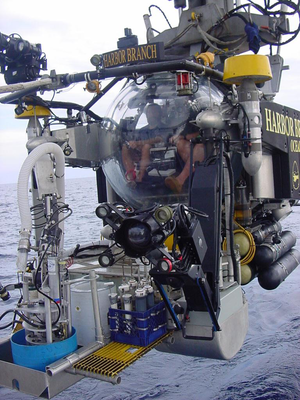 Johnson Sea Link submersible, ca. 2005
| |
| History | |
|---|---|
| Namesake | John Seward Johnson I, Edwin Albert Link |
| Builder | (JSL I) Edwin Albert Link / Alcoa; (JSL II) Harbor Branch Oceanographic Institution |
| Launched | (JSL I) 1971; (JSL II) 1975 |
| General characteristics (JSL I, 1974) | |
| Length | 23 feet (7.0 m) |
| Beam | 7.9 feet (2.4 m) |
| Draft | 7.1 feet (2.2 m) |
| Propulsion | 8 28-VDC electric motors |
| Speed | 1.75 knots (3.24 km/h; 2.01 mph) |
| Test depth | 3,000 feet (910 m) |
| Complement | 1 pilot, 3 observers[1] |
Johnson Sea Link was a type of deep-sea scientific research submersible built by Edwin Albert Link. Link built the first submersible, Johnson Sea Link I, in 1971 at the request of his friend Seward Johnson, founder of the Harbor Branch Oceanographic Institute. It was the successor to Link's previous submersible, Deep Diver, which had been determined to be unsafe for use at great depths or in extremely cold temperatures.[2][3] Johnson Sea Link II was built in 1975.[3]
The Johnson Sea Link submersibles carried a crew of four in two separate compartments.[4] The aft compartment was originally designed for lockout diving, allowing two divers to be compressed to the ambient pressure of the ocean and leave the submersible to work underwater. The forward pilot's compartment was an acrylic sphere with a diameter of 5 feet (1.5 m), providing a panoramic underwater view for the pilot and an observer.[2][3]
- ^ Busby, R. Frank (1976). Manned Submersibles. Office of the Oceanographer of the Navy. p. 143.
- ^ a b Link, Marion Clayton (1973). Windows in the Sea. Washington, D.C.: Smithsonian Institution Press. ISBN 0-87474-130-0. LCCN 72-93801.
- ^ a b c "NOAA Ocean Explorer: Johnson Sea-Link Submersible". National Oceanic and Atmospheric Administration. 2012-07-19. Retrieved 2013-02-06.
- ^ Thomas, Steve (17 April 2022). "Subs evoke memories as Harbor Branch celebrates 50th". Vero News. Retrieved 20 April 2022.